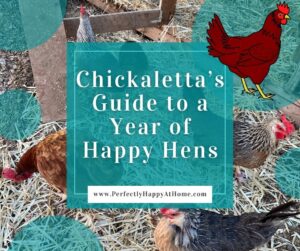 Today, Chickaletta and her sisters got some much-needed attention! Of course, these backyard beauties are mostly self-sufficient, from a day-to-day aspect, but they do need my care and attention from time to time! If you’re curious about how I maintain a clean, safe, productive environment for our fine-feathered ladies, you’ve come to the right place! I’ll give you a quick rundown of what it takes to keep these clucking egg-layers of ours happy and laying throughout the seasons!
Today, Chickaletta and her sisters got some much-needed attention! Of course, these backyard beauties are mostly self-sufficient, from a day-to-day aspect, but they do need my care and attention from time to time! If you’re curious about how I maintain a clean, safe, productive environment for our fine-feathered ladies, you’ve come to the right place! I’ll give you a quick rundown of what it takes to keep these clucking egg-layers of ours happy and laying throughout the seasons!
About once per quarter, I like to give the coop and run a good raking, leveling, and a solid new layer of fresh straw…you know, really pamper them. It’s really not a hard task, just a little dusty, but it’s fun to see them really dive into the new straw!! They love sifting through, scratching for this or that, fluffing it up, and “redecorating” their whole area. It’s quite comical to watch and can provide lots of entertainment to us humans. As each new season arrives, the ladies also go through their own changes. They molt, they have times of rest from laying, they have extra productive times too…it’s all in a year’s cycle, if you’ve got laying hens. So, I guess we can say that as the year progresses, I do all I can to keep them happy and healthy, and they do all they can to live their best Chickie-girl life!
Before I begin, let me remind you that we live in sunny Arizona, where we do have seasons, but they might look very different than the seasons you experience where you are located. We happen get quite cold in the winter (below freezing at times, with hail, but no snow), quite wet and windy in monsoon season, and of course we also spend 4 or so months of the year well above 105 degrees, with at least 2 of those months topping around 112 daily. That’s a large temperature range for my feathery beauties to acclimate to, but they do a fine job of it. I do all I can to make their days as comfortable and rewarding as possible for them during each new seasonal weather experience.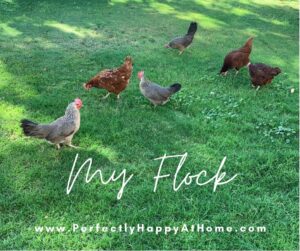
Let me break this down by “Arizona season” so it’s nice and easy:
- WINTER: 30-80 degrees, night to day (Here in AZ, this is from mid-December through early March, as far as my Chickies are concerned)
- SPRING: 50-90 degrees, night to day (mid-March through May, if we’re lucky!)
- SUMMER: 95-120 degrees, night to day (end of May through early October)
- AUTUMN: 75-95 degrees, night to day (October through mid-December)
Now that you’ve got this information, here’s how I adapt what we do for the laying ladies by the season. (As a side note: Yes, I know they have feathers and are very weather-adaptable, but I try to make them the most comfortable I can during each season, so they stay happy. I just love these silly feathered hens so much; I can’t help it! Ha!)
In the WINTER, I like to keep them snug and warm at night. Our coop is built with plenty of airflow, due to other seasons getting so hot, so when it gets down in the 30’s and 40’s, I like to make sure they have another layer of insulation. I wrap the coop in tarps (carefully leaving vents for fresh air, of course!) once the sun goes down. This helps them stay nice and insulated while they sleep. I have no idea if there is a scientific reason for this, but I do notice that they lay more actively during the otherwise lazier winter days if I do this for them. In other places where the weather gets colder, I know that coop heaters and water warmers are sometimes needed to make sure nothing gets frozen but luckily here, tarps are sufficient. The tarps get rolled back during the daytime to allow fresh air and light to circulate freely. I also like to supplement their protein sources when the weather is colder. I add dried meal worms, extra seeds, and sprouted lentils to their diet during this time. Additionally, this is a season I like to supplement their calcium intake by using their own eggshells I have saved, baked, and crushed. See my easy instructions for doing that here. I also take this time to check in my garden…if there are herbs or veggies that look like they won’t make it through the winter, I pull them while they’re still alive and give them, roots and all, to the happy hens! They love to pick at what’s left of any green leaves, and they obtain starches and sugars from the roots. It’s a practice that’s good for the garden, the gardener, and the Chickies!
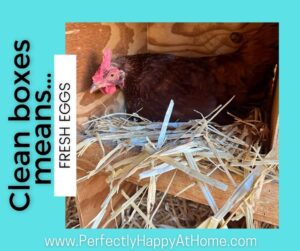 As the season shifts into SPRING, and the daytime temperatures start to rise, I remove the tarps from the coop completely. Once the nighttime temperatures no longer reach the 40’s, the hens’ feathers do a fine job at keeping them at just the right temperature. This is also the easiest season for me to give the coop a super thorough clean-out. I rake/scrape out all old poop (this makes great garden fertilizer, since it’s mixed with straw…just let it sit for about 2 months to allow the potency to settle before adding it into the garden!), sweep any debris out of/off of the laying boxes, and see about replacing any aging feeders or waterers. It’s a good time to spend extra time out there, since the weather is so nice! In the spring, some of the hens inevitably decide it’s time molt, which means they don’t lay eggs while they’re busy pulling out old, and growing in new, feathers. They can look pretty raggly, poor things, but after about a month or so, their gorgeous new feathers are soft, full, and shiny. Soon, they’re ready to lay us delicious fresh eggs again, which we are always ready to thank them profusely for!
As the season shifts into SPRING, and the daytime temperatures start to rise, I remove the tarps from the coop completely. Once the nighttime temperatures no longer reach the 40’s, the hens’ feathers do a fine job at keeping them at just the right temperature. This is also the easiest season for me to give the coop a super thorough clean-out. I rake/scrape out all old poop (this makes great garden fertilizer, since it’s mixed with straw…just let it sit for about 2 months to allow the potency to settle before adding it into the garden!), sweep any debris out of/off of the laying boxes, and see about replacing any aging feeders or waterers. It’s a good time to spend extra time out there, since the weather is so nice! In the spring, some of the hens inevitably decide it’s time molt, which means they don’t lay eggs while they’re busy pulling out old, and growing in new, feathers. They can look pretty raggly, poor things, but after about a month or so, their gorgeous new feathers are soft, full, and shiny. Soon, they’re ready to lay us delicious fresh eggs again, which we are always ready to thank them profusely for!
As SUMMER approaches, our temperatures really heat up quickly. In about the span of a week, we can go from the nice coolness of spring to never reaching below 95, even at night! It can be drastic and fast, so I try to have everything we need to keep our hens cool on hand ahead of time. I do actually put one lightweight tarp back up on just one side of the coop to provide shade. Our sun here is so strong that it can feel like it’s trying to fry us during this season. In addition to a tarp shade on the sunny side of the coop, I utilize several long pieces of plywood to make shelters and lean-tos throughout the run, so as the ladies are braving the heat, they have plenty of places to escape it and cool their feet! Some people use shade sails quite successfully instead. I also purchase extra plastic bins (think small wash basin size!) and a plastic kiddie/toddler pool to use as additional water sources for them to have full access to at all times. I make sure these stay clean and fresh by emptying them and refilling daily. One thing about our extreme heat…the ladies can get dehydrated and perish in a matter of hours, so these extra water and shade provisions truly are essential for their survival. Once or twice per day, I use the garden hose to spray down the whole run, including the ladies’ feathers. They don’t mind the water at all; in fact, they have even learned to appreciate this ritual that cools them off so nicely. On days where the heat reaches into the hundred-and-teens, I have pre-made ice treats I keep in the freezer to pull out. To make these, I throw whatever kitchen produce and grain scraps I have lying about into 1–2-quart plastic tubs, fill with water, and place into the freezer. I pull them out as needed, placing them in the run under the shades. As the ice melts, they enjoy standing on it to cool their little feet, and of course pecking at the food scraps attracts them to hanging out near these cooler oasis points. I also make sure to serve plenty of hydrating fruits as daily treats…watermelon, berries, cantaloup, and cucumbers are their favorites! All in all, I would say that the summer season is definitely the most work-intensive for me as the chicken mom, because of the constant monitoring, watering, and cooling that needs to be done several times each day.
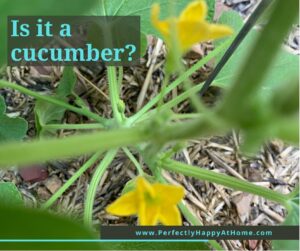 When AUTUMN finally approaches, it brings some relief to both my laying ladies and me! The temperatures become more manageable, the garden begins to recover from summer’s fury, and Chickaletta and her sisters are loving life again. The evenings once again bring respite from the day’s heat, which isn’t quite as unbearable anymore, either. Just as I do in the spring, I like to a major tidy-up in the coop again around October. A fresh layer of straw, nice and neat laying boxes, and a scrubbed-out feeder and waterer always make a difference! Autumn is also the time where treats such as pumpkins and other squashes are readily available, too. They love these! I simply split one open, and the lucky, clucking ladies spend several days pecking at it, enjoying every part from the seeds to the flesh of the squash. I simply collect the dried rind from the floor in about a week. I do believe that this is how I end up getting “mystery vines” growing in the yard, which is a fun and welcome adventure as we attempt to guess what we will be enjoying when the mystery seeds have fully grown! During this gentler weather season, the ladies usually are in high egg-production mode, which means that I make sure to be prompt about collecting eggs a few times per day. I do this to avoid the dread of layer-hen owners: the ladies eating their own eggs and leaving none for us! This can become quite a nuisance, but I have found that by collecting frequently, they rarely have a chance to get into this bad habit. Since they lay so many during this season, I also give them more crushed eggshells mixed into their feed to replenish their calcium again, so our eggs don’t have thin, brittle shells. It’s the ultimate in recycling efforts! We all enjoy this season together (the Chickies and me!), and easily slip into the lull of the gorgeous days and comfortable, cool nights.
When AUTUMN finally approaches, it brings some relief to both my laying ladies and me! The temperatures become more manageable, the garden begins to recover from summer’s fury, and Chickaletta and her sisters are loving life again. The evenings once again bring respite from the day’s heat, which isn’t quite as unbearable anymore, either. Just as I do in the spring, I like to a major tidy-up in the coop again around October. A fresh layer of straw, nice and neat laying boxes, and a scrubbed-out feeder and waterer always make a difference! Autumn is also the time where treats such as pumpkins and other squashes are readily available, too. They love these! I simply split one open, and the lucky, clucking ladies spend several days pecking at it, enjoying every part from the seeds to the flesh of the squash. I simply collect the dried rind from the floor in about a week. I do believe that this is how I end up getting “mystery vines” growing in the yard, which is a fun and welcome adventure as we attempt to guess what we will be enjoying when the mystery seeds have fully grown! During this gentler weather season, the ladies usually are in high egg-production mode, which means that I make sure to be prompt about collecting eggs a few times per day. I do this to avoid the dread of layer-hen owners: the ladies eating their own eggs and leaving none for us! This can become quite a nuisance, but I have found that by collecting frequently, they rarely have a chance to get into this bad habit. Since they lay so many during this season, I also give them more crushed eggshells mixed into their feed to replenish their calcium again, so our eggs don’t have thin, brittle shells. It’s the ultimate in recycling efforts! We all enjoy this season together (the Chickies and me!), and easily slip into the lull of the gorgeous days and comfortable, cool nights.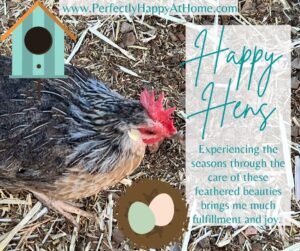
Well friends, there you have it! Chicakletta’s Guide to a Year of Happy Hens! I hope that through sharing about our adventures with our feathered friends, and the joys they bring, you are able to take some joy home too. Any maybe even a few tips and tricks for your backyard Chickies! Wishing you a year of love, blessings, and as always…discovering the joy in your home, whatever and wherever that might be!
